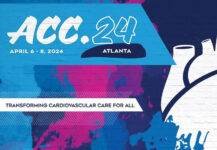Regardless of whether it is attempted through percutaneous coronary intervention (PCI) or myocardial revascularization surgery (MRS), complete revascularization (CR) is not always achieved. Overall, it is more frequent with surgery than with percutaneous treatment. Additionally, incomplete revascularization (IR) has proven to be associated with worse outcomes compared to CR. Researchers conducted an analysis of the…
ACC 2024 | REDUCE AMI: Beta-Blockers after Myocardial Infarction and Preserved Ejection Fraction
Most clinical trials have shown benefits of beta blockers after acute myocardial infraction, including patients with extensive AMI, and these were carried out in the era before AMI was diagnosed with biomarkers and prior to treatment with coronary angioplasty, use of antithrombotic agents and high intensity statins, and angiotensin-aldosterone system inhibitors. The aim of this…
ACC 2024 | PREVENT Study
The use of intravascular imaging to identify vulnerable plaque (VP) has proven to be very useful, as such plaque is associated with an increase in major adverse cardiac events. Optimal medical treatment is currently considered the standard strategy to stabilize VP. However, the safety and effectiveness of preventive treatment with percutaneous coronary intervention (PCI) in…
ACC 2024 | DanGer-Shock Trial
Cardiogenic shock will develop in approximately 10% of patients with ST elevated acute MI (STEMI), and unfortunately, only half of these patients will survive. Researchers have been looking into the Impella system to manage this severe complication. It consists of an aortic transvalvular pump designed to deliver blood from the left ventricle into the systemic…
Lithotripsy in the “Real World”: REPLICA EPIC-18 Study
Severe persistent calcification of the coronary arteries has been associated with different factors, such as advanced age, hypertension, dyslipidemia, smoking, and kidney failure, among others, and continues to be one of the challenges to stent implantation because of it impact on device advancing, drug release and adequate positioning. Intravascular lithotripsy (IVL) is a technique that…
Physiologically Significant Obstructions in the Left Main Coronary Artery: Revascularizing vs. Deferring
Most randomized studies on revascularization in stable coronary artery disease exclude left main coronary artery disease (LMCAD). One example of this was the ISCHEMIA study. However, the benefits of functional lesion assessment, as demonstrated in the FAME studies, highlight the importance of this tool in guiding decisions regarding revascularization. Nevertheless, the clinical outcomes of patients…
Virtual Flow Reserve (VFR): Virtual Physiological Test with OCT
Assessing intermediate coronary lesions with intracoronary physiology tests such as fractional flow reserve (FFR) or other non-hyperemic indices is considered the standard of care by both American and European societies. Likewise, intravascular imaging techniques (IVI), be it IVUS or optical coherence tomography (OCT), are of great use in assessing and guiding complex coronary lesions and…
AGENT-IDE: Drug Coated Balloons for Instent Restenosis
Drug eluting stents (DES) have improved considerably over the years, reducing the initial indices of instent restenosis (ISR) by roughly 5-10% a year in USA. However, DES failure might lead to neointimal hyperplasia and neoatherosclerosis, which increases the chance of developing chronic and acute coronary syndromes. Drug coated balloons (DCB), which administer anti-proliferative agents with…
Rehospitalization After Treatment of Left Main Coronary Artery Disease and Its Prognosis: Sub-Analysis of the EXCEL Study
Individual randomized studies have shown variable results regarding the mortality risk following treatment of left main coronary artery disease (LMCAD), either through percutaneous coronary intervention (PCI) or coronary artery bypass grafting (CABG). However, upon assessment of the latest meta-analyses (with matched data), similar risks of all-cause and cardiovascular mortality have been reported for both groups.…
ISCHEMIA Outcomes: Does Sex Have Any Impact?
We are well aware of CAD physiopathological disparities and how it manifests differently in men and women. The ISCHEMIA study (International Study of Comparative Health Effectiveness with Medical and Invasive Approaches) has revealed that during 3.2 years no differences were seen in the incidence of ischemic events when comparing an invasive strategy (INV) vs a…
Use of IVL in Calcified Coronary Lesions in a Real World Population
The presence of calcification in coronary arteries (CAC) remains a challenge for the percutaneous treatment of these lesions. Several studies have established the link between CAC and poor long term results. Intravascular lithotripsy (IVL) has surged as a tool to induce calcified plaque fracture. Even though studies on this strategy are not randomized, they have…








